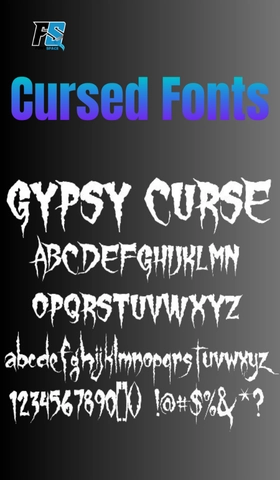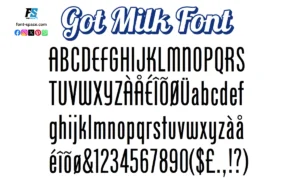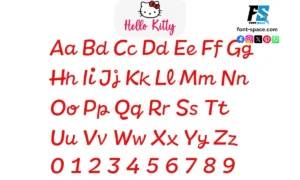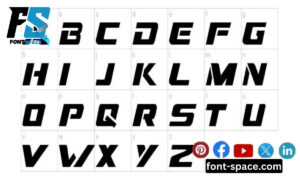If you’ve spent time on the internet, you might have seen a “cursed font.” These strange, distorted fonts make the text look eerie and unnatural. People use cursed fonts to stand out or to give off a creepy vibe. But where did these fonts come from, and why do they keep gaining popularity? Let’s find out!
What Is a Cursed Font?
A cursed font isn’t a font in the usual sense. Fonts like Arial or Times New Roman follow basic rules of design. They are made for easy reading and visual appeal. But a cursed font does the opposite. It is made to look strange, broken, or unsettling. It can have letters that seem to float, overlap, or look like they belong to different alphabets. The letters might have odd shapes, extra marks, or odd spacing.

These fonts often feel “wrong” or broken. Yet, many people like them because they look different. It’s a way to make text stand out in a sea of uniform fonts.
One popular place people encounter cursed fonts is on social media. Some use cursed fonts in their usernames or comments to grab attention. Websites like Lingojam or FontsCopyPaste let users generate these fonts for free. With just a few clicks, normal text turns into strange symbols.
The Origins of Cursed Fonts
Cursed fonts come from Unicode. Unicode is a system that allows computers to understand and display text. It includes not only standard letters but also symbols from many languages and special characters. By mixing these characters, you can create the illusion of a strange, cursed font.
Unicode was first launched in 1991 and now supports over 159 modern and historic scripts. Because Unicode has so many characters (over 143,000!), it’s easy to find ones that look odd or out of place next to regular letters. When these symbols are mixed into the text, it creates the “cursed” effect.
Why Are Cursed Fonts So Popular?
Cursed fonts grab attention. In the crowded world of online content, it can be tough to stand out. A unique or strange-looking font can make people stop and look at your post or comment. This is especially true on platforms like TikTok, Instagram, or Twitter, where users are scrolling quickly. A cursed font disrupts the flow of the page and forces the viewer to pause.
These fonts can also help create a certain mood. Want to give off a creepy or spooky vibe? A cursed font can do that for you. Many people use them around Halloween or in contexts where they want their text to feel unsettling.
Besides aesthetics, cursed fonts are often used for humor. Imagine reading a formal sentence in a distorted font. The mix of the formal tone and the weird appearance of the text can make it funny or absurd.
How To Use Cursed Fonts
If you want to use a cursed font, the process is simple. Websites like Lingojam and FontsCopyPaste make it easy to generate these fonts in seconds. Here’s a quick step-by-step:

- Visit a cursed font generator site (like Lingojam).
- Type in the text you want to change.
- The site will instantly convert your normal text into a cursed font.
- Copy and paste the converted text where you want it (social media, text messages, etc.).
The best part is that cursed fonts work on almost any platform. Because they’re based on Unicode, most social media platforms, messaging apps, and even Word documents can display them without issue.
Real-Life Uses of Cursed Fonts
People aren’t the only ones using cursed fonts. Brands and marketers have also started to use them. For example, in 2021, a clothing brand ran a Halloween campaign using cursed fonts to give their ads a spooky touch. These fonts have also popped up in memes, where the strange text adds to the joke.
Cursed fonts are also found in art. Digital artists and meme creators use them to make text stand out or feel off. This gives their creations a unique look.
The Downside of Cursed Fonts

While cursed fonts are fun, they have some downsides. The main issue is readability. Because these fonts mix symbols with normal letters, they can be hard to read, especially for long pieces of text. This is fine for a short username or comment, but it can become annoying if overused.
Some platforms also don’t support all Unicode characters. If you try to use a cursed font on a website or app that doesn’t fully support Unicode, your text might appear as boxes or question marks. This is known as “tofu”, and it happens when the platform can’t read the symbols.
Another downside is that cursed fonts don’t work well for screen readers. Screen readers are tools that help visually impaired users by reading text aloud. Because cursed fonts use odd symbols, screen readers might not be able to understand them, making the content less accessible.
Alternatives to Cursed Fonts
If cursed fonts feel too extreme, there are other ways to make your text stand out. You can use:
- Bold text
- Italic text
- Underlined text
Some platforms also allow colored text or different fonts, which can give your content a unique touch without making it hard to read.
Fun Fact About Cursed Fonts
Here’s an interesting fact: one of the earliest forms of a “cursed” font can be found in old Gothic scripts. These medieval fonts were hard to read and were used in books from the 15th century. Some historians think the difficult-to-read style gave these texts an aura of mystery, much like how cursed fonts work today.
Conclusion
Cursed fonts are a great way to make your text stand out online. Whether you want to create a spooky mood, add humor, or just be different, cursed fonts let you do it. They are easy to generate, free to use, and work on most platforms. Just remember to use them wisely. Too much-cursed font can make your text unreadable, and it may not work well with all systems.
If you want to have fun with your text, give cursed fonts a try. But also think about your audience. Not everyone will enjoy reading distorted letters. A little goes a long way when it comes to using cursed fonts in your online content.




